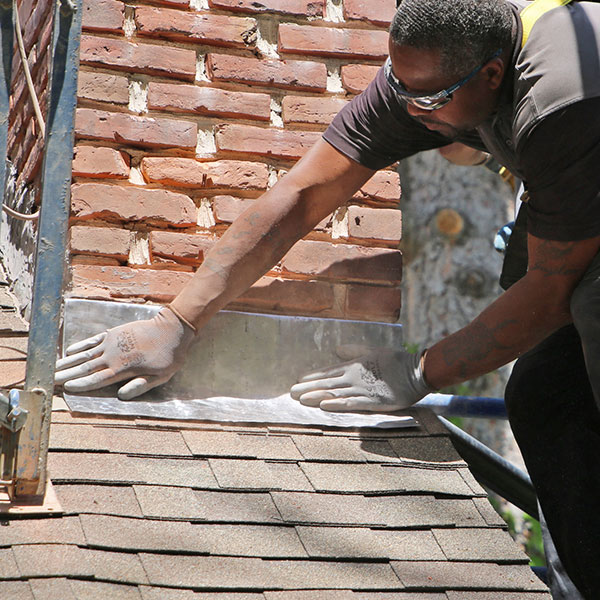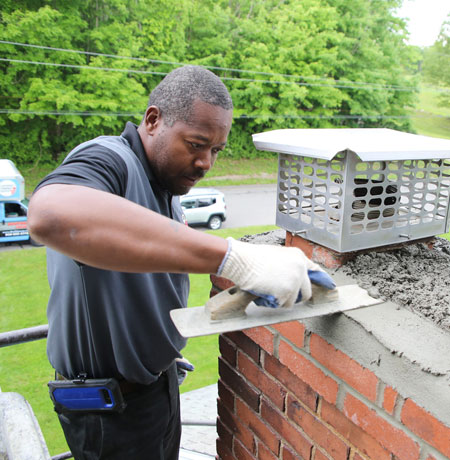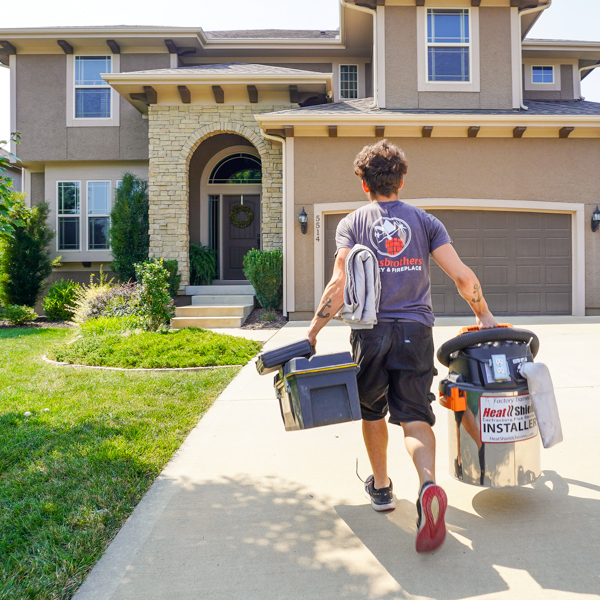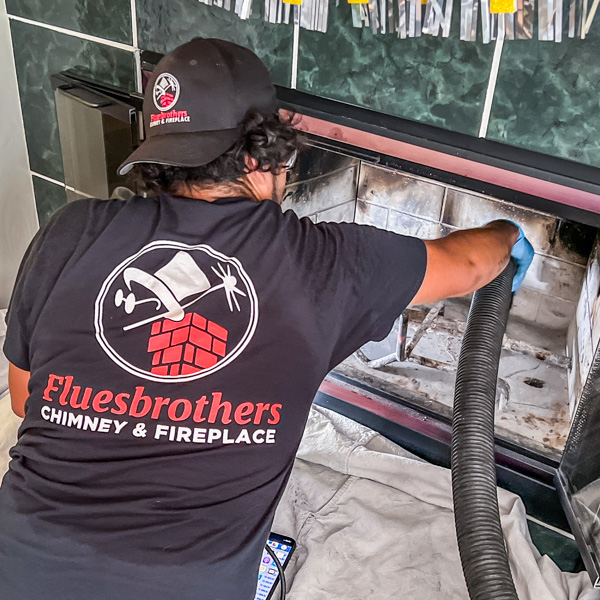How Do I Know If Something Is Wrong With My Chimney?
A well-maintained chimney is essential for home safety and the efficient functioning of your fireplace or wood-burning stove. Over time, chimneys can develop various issues that may pose a risk to your property or even your health.
The professionals at Lindemann know how to tell if there is anything wrong with your chimney. We will discuss some common chimney problems, how to identify them, and what steps you can take to keep your chimney in good working condition.
Signs of Chimney Damage
The first way to find out if there is something wrong with your chimney is to check for signs of damage. This includes visible signs of damage, internal issues in your chimney, performance issues, and water damage. Let’s take a look at each of these signs.
Visible damage
Cracks or gaps in the masonry, damaged chimney caps or crowns, and leaning or bulging chimney structures are all signs of visible damage. These issues can compromise the structural integrity of your chimney and allow water to seep into your home, causing further problems.
Interior issues
Creosote buildup, a highly flammable substance that results from burning wood, can accumulate in your chimney and pose a fire hazard. Additionally, a damaged flue liner can lead to heat and combustion byproducts escaping into your home. Obstructions in the chimney, such as debris or animal nests, can also cause blockages and affect the performance of your fireplace.
Performance issues
If you notice poor draft, smoke entering your home, or unusual odors coming from your chimney, these may indicate problems with the chimney’s functioning. These issues should be addressed immediately to prevent harmful gasses from entering your living space.
Water damage
Stains or discoloration on walls or ceilings, damp or moldy smells, and efflorescence (a white, powdery substance) on the chimney surface are all signs of water damage. Water can weaken the chimney structure and lead to more severe issues if not addressed.
Causes of Chimney Problems
Once you’ve identified that there is indeed a problem with your chimney, next it’s important to identify what caused the issue. This way, you can properly address the problem and do what you can to make sure that it doesn’t continue once you fix the damage. Here are the most common causes of chimney problems:
- Weather-related damage: Freeze-thaw cycles, high winds, and heavy rain or snow can all cause damage to your chimney over time. Regular inspections and maintenance can help you identify and address these issues before they become more serious.
- Poor maintenance: Neglecting regular chimney cleanings and ignoring minor repairs can lead to more significant problems. A well-maintained chimney is less likely to develop severe issues and will function more efficiently.
- Improper construction: Inadequate materials or incorrect sizing and design can cause chimney problems from the outset. Always ensure that your chimney is built to code and by a reputable contractor such as those at Lindemann.
The Importance of Chimney Inspections
Regular chimney inspections are crucial for prevention and early detection of potential problems. There are three levels of chimney inspections: Level 1, 2, and 3, with each level increasing in detail and scope. Schedule an inspection at least once a year, after significant weather events, or before buying or selling a home to ensure your chimney is in good working order.
Chimney Maintenance Tips
To ensure the safety and efficiency of your chimney, it is essential to follow a proper maintenance routine. Below are some expanded chimney maintenance tips to help you keep your chimney in good working order. These chimney maintenance tips, you can help extend the lifespan of your chimney, improve its performance, and ensure the safety of your home and family.
Hire a professional chimney sweep
A certified chimney sweep such as the professionals at Lindemann can perform thorough cleanings and inspections, helping you identify and address potential issues before they become more severe. It is recommended to have your chimney cleaned and inspected at least once a year, preferably before the start of the heating season.
Burn only seasoned, dry wood
Burning well-seasoned, dry wood is crucial for minimizing creosote buildup in your chimney. Freshly cut or wet wood produces more creosote, leading to faster accumulation and increasing the risk of chimney fires. Seasoned wood has been allowed to dry for at least six months, has a moisture content of 20% or less, and will produce less smoke and creosote when burned.
Install a chimney cap
A chimney cap is an essential accessory that prevents debris, animals, and water from entering your chimney. It also helps keep sparks from escaping the chimney and landing on your roof or nearby combustible materials. Installing a chimney cap with a mesh screen can keep out birds, rodents, and other critters that might build nests and create blockages in your chimney.
Waterproof your chimney
Water damage can lead to a variety of issues, including weakened masonry, staining, and even structural damage. Applying a waterproof sealant specifically designed for chimneys can help protect your chimney from water penetration. A quality chimney sealant should be vapor permeable, allowing moisture from inside the chimney to escape while preventing water from entering.
Maintain proper chimney clearance
Keep the area around your chimney free from combustible materials such as leaves, branches, and other debris. Ensure that your chimney has at least a 2-foot clearance from surrounding trees and structures. This will help prevent fires and ensure proper draft and airflow.
Check flashing and sealant
The flashing around the base of your chimney, where it meets the roof, is crucial for preventing water leaks. Inspect the flashing regularly for signs of damage, rust, or lifted edges. Seal any gaps or cracks with a high-quality sealant to keep water from seeping into your home.
Monitor chimney odors
Unusual or foul odors coming from your chimney can indicate problems such as excess creosote buildup, moisture issues, or even a dead animal trapped inside. If you notice any strange smells, contact a professional chimney sweep to investigate the issue and provide appropriate solutions.
Conclusion
Being aware of the warning signs of chimney damage and following proper maintenance tips can help you avoid costly repairs and ensure the safety of your home. Remember, proactive care is the key to keeping your chimney functioning efficiently and safely. Consult with a professional chimney sweep for regular inspections and repairs, and enjoy the warmth and comfort that your fireplace provides.
 Chimney leaks can lead to costly repairs
Chimney leaks can lead to costly repairs Since you’re unlikely to see the top of your chimney often (or at all), you won’t be aware of the damage until it’s a larger issue. During your annual inspection, your chimney sweep can let you know if this needs to be repaired.
Since you’re unlikely to see the top of your chimney often (or at all), you won’t be aware of the damage until it’s a larger issue. During your annual inspection, your chimney sweep can let you know if this needs to be repaired. How to Remove Fireplace Soot From Your Carpet
How to Remove Fireplace Soot From Your Carpet